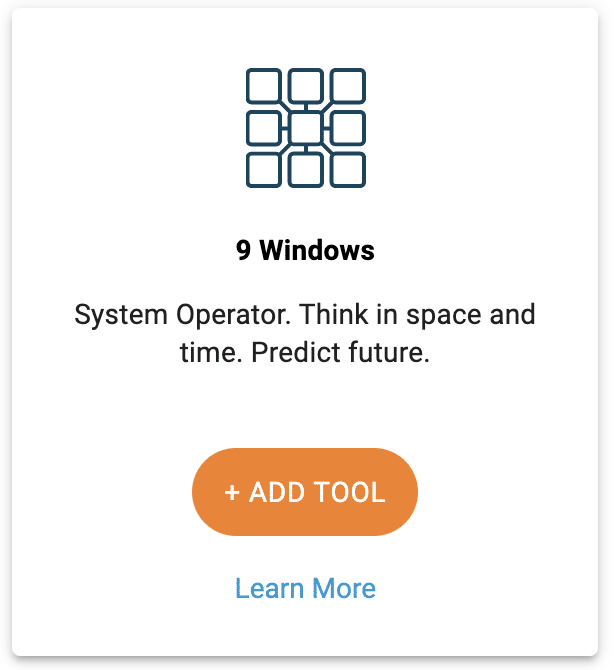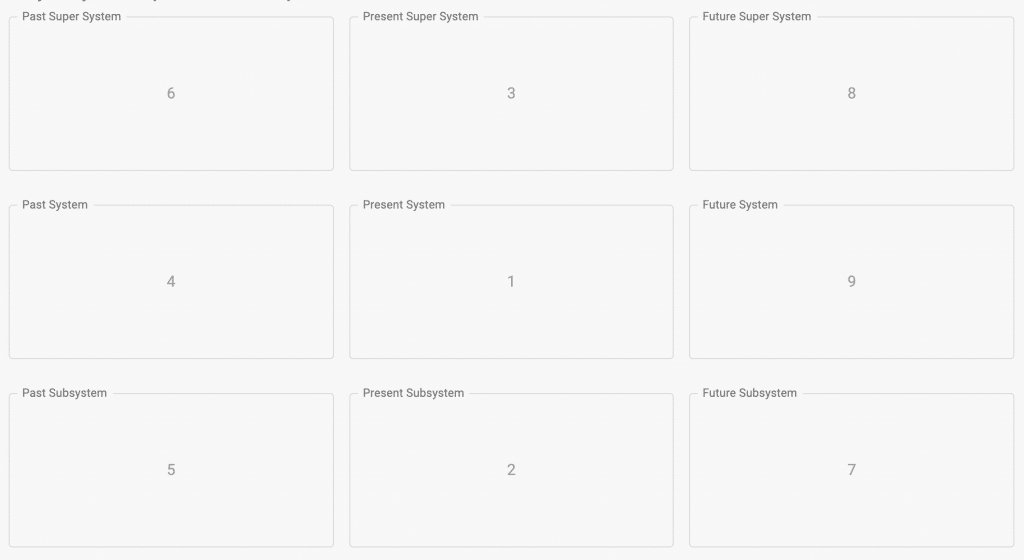What is 9 Windows tool ?
The 9 Windows tool, also known as System Operator ‘tool’, is a simple means of helping users to think in terms of TIME and SPACE. The basic principle of operation divides ‘the world’ into nine segments, as shown below.

The central box of the nine – system, present – is the one our brains naturally migrate to whenever we are given a problem situation. In other words, when we are asked to think about ‘designing a better pen’, our brains are likely to immediately conjure up the image of a pen (‘the system’) being used to write (‘the present’).
The system operator tool is trying to get us to think about the pen in different contexts and perspectives. For example:
- the bigger (super-system) context – the person holding the pen, the paper, the desk, etc
- the smaller (sub-system) context – the components of the pen, the ink molecules, etc
- the pen in the past – manufacture, shipping, unpacking, preparing to write, etc
- the pen in the future – what happens to the pen immediately after we’ve finished writing, right through to its disposal after it has run out.
The point of this exercise is to help us overcome the psychological inertia of present and system-level only thinking. While the above is just one very simple example of 9 Windows usage. Every innovator will eventually develop his own thinking process. The main purpose, however, is to put the innovator in a situation that will help him to break out of psychological inertia and think outside of the box.
9 Windows in the world of PRIZ Innovation Platform
We have a number of articles talking about 9 Windows applications and we encourage you to revisit them. In this article, we want to explain how to use the 9 Windows tool offered in the PRIZ Innovation Platform.
Creating 9 Windows tool
As we already described in the Creative Tools article, creative thinking tools can only be used within a project’s scope. At this point, we assume that there we have already created the project.
Now, click on Creative Tools on the left side menu of the project. You will be taken to the creative tools page, where you can see all the tools already used in the project and create others.

To use 9 Windows tool, click on + NEW button in the top right corner of the page.

Once you see a dialog with all available tools, select 9 Windows from the options.

Once the tool is ready to use, you will be redirected to it.
Using 9 Windows tool

As shown above, 9 Windows is a matrix of 9 fields. The fields should be filled in a numbered order for the best results.
1. Present System
Describe the subject of your analysis.
Example: Digital image
2. Present Subsystem
This field will hold one or more components of the system.
Example: Pixel (virtual) on physical data storage, virtual particles on a physical storage
3. Present Super System
Describe which system/s this subject is part of.
Example: Digital image album, PowerPoint presentations, etc…
4. Past System
Describe how the subject system looked like in the past
Example: Photo image
5. Past Subsystem
List the component/s of the system in the past.
Example: Physical particles on physical photo paper, physical particles on a physical storage
6. Past Super System
Similar to #3, which bigger systems the subject system was part of in the past.
Example: Photo album, a physical album on a physical storage
Now the creative part of the thinking process. Using both dimensions of space and time, we can start thinking about how the system might look in the future. This part should also be done in stages.
7. Future Subsystem
Using the information of past and present subsystem, and some creativity, think about the possible options of how the subsystem might look in the future.
Example: Pixel on virtual storage, virtual particles on virtual storage
Physical particles on physical storage -> virtual particles on physical storage -> virtual particles on virtual storage
8. Future SuperSystem
Similar to #7, using the information of past and present super system, think about the possible options of how the super system might look in the future.
Example: Digital album on virtual storage
Physical album on physical storage -> digital album on physical storage -> digital album on virtual storage
9. Future System
Now, using all the information gathered in the matrix, think about the option of what the subject system might look like in the future. Here, everything should be taken into account, including the future super and subsystems and how the system might fit into that puzzle.
Example: Virtual image on virtual storage
Your 9 windows matrix is complete. You are ready to generate new creative ideas if you haven’t already.